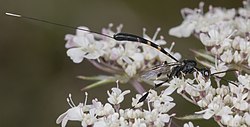This article needs additional citations for verification .(March 2011) |
| Gasteruption jaculator | |
|---|---|
 | |
| Female | |
| Scientific classification | |
| Kingdom: | Animalia |
| Phylum: | Arthropoda |
| Class: | Insecta |
| Order: | Hymenoptera |
| Family: | Gasteruptiidae |
| Genus: | Gasteruption |
| Species: | G. jaculator |
| Binomial name | |
| Gasteruption jaculator | |
| Synonyms | |
| |
Gasteruption jaculator is a species of wasp in the family Gasteruptiidae.
